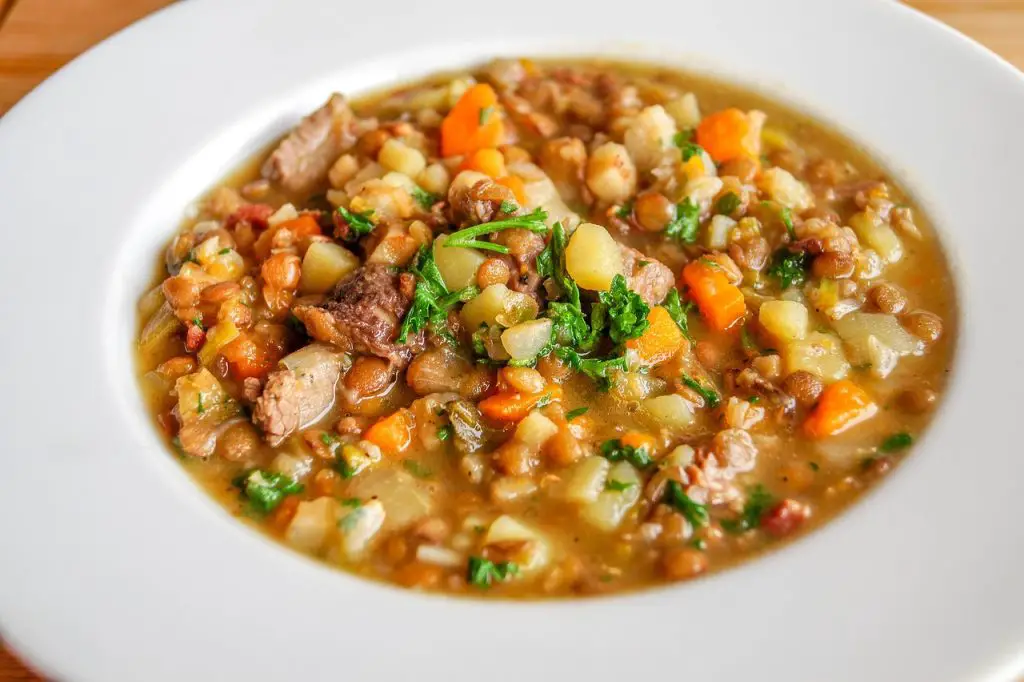New Year’s Eve is a time of celebration and reflection as we bid farewell to the old year and welcome the new one with open arms. It’s a time for fireworks, champagne toasts, and resolutions for the year ahead. But in addition to these customs, many cultures around the world have unique food traditions associated with New Year’s that are believed to bring good luck, prosperity, and happiness. In this article, we’ll explore 15 such New Year’s food traditions from different corners of the globe.
Black-Eyed Peas – Southern United States
In the southern United States, it’s a common tradition to eat black-eyed peas on New Year’s Day. These legumes are believed to bring good luck and prosperity for the year ahead. Often, they are cooked with ham hocks and served with collard greens, which represent paper money. It’s thought that the more black-eyed peas you eat, the more luck you’ll have in the coming year.
Lentils – Italy
In Italy, lentils are a popular New Year’s dish. These tiny legumes are believed to resemble coins, symbolizing wealth and prosperity. Italians often prepare a hearty dish called “lenticchie,” which combines lentils with sausage or pork for a delicious start to the year.
12 Grapes – Spain
In Spain, the stroke of midnight on New Year’s Eve is met with a unique tradition known as “Las doce uvas de la suerte” or “The 12 grapes of luck.” As the clock chimes 12 times, people eat one grape with each toll of the bell, making a wish with each grape. If you successfully consume all 12 grapes before the last chime, it’s believed to bring good luck for the 12 months ahead.
Soba Noodles – Japan
In Japan, it’s customary to eat toshikoshi soba, or “year-crossing noodles,” on New Year’s Eve. These long, thin buckwheat noodles symbolize longevity and are enjoyed in a flavorful broth. Eating soba noodles on New Year’s Eve is believed to ward off evil and bring good luck in the coming year.
Hoppin’ John – Southern United States
Hoppin’ John is another beloved Southern dish enjoyed on New Year’s Day. It consists of black-eyed peas cooked with rice and often served with greens. The dish is said to bring good fortune, especially when served with a side of cornbread, which represents gold.
Pomegranates – Greece
In Greece, pomegranates are a symbol of good luck and abundance. On New Year’s Day, it’s customary to break open a pomegranate and share it with family and friends. The vibrant red seeds are said to represent fertility, prosperity, and good fortune.
Cabbage – Germany
In Germany, eating sauerkraut or cabbage on New Year’s Day is believed to bring good luck. Cabbage leaves are thought to symbolize prosperity and wealth, as they resemble folded money. Often, sauerkraut is served alongside pork, another symbol of prosperity.
Ring-Shaped Foods – Netherlands
In the Netherlands, it’s common to eat ring-shaped pastries known as “oliebollen” on New Year’s Eve. These deep-fried doughnuts are believed to represent the circle of life and the year coming full circle. They are often dusted with powdered sugar and enjoyed as a sweet treat to welcome the new year.
Fish – Many Cultures
Fish is a popular New Year’s dish in many cultures around the world. In China, for example, fish is served whole, with the head and tail intact, symbolizing a good beginning and ending for the year. In other cultures, fish is associated with abundance and wealth, making it a common choice for New Year’s feasts.
Pork – Various Countries
Pork is another meat that’s commonly associated with good luck on New Year’s. In some countries, like Germany, it’s served with sauerkraut, while in other places, it’s enjoyed as roast pork. The fatty nature of pork is believed to symbolize abundance and prosperity.
Round Fruits – Philippines
In the Philippines, it’s customary to have a table full of round fruits on New Year’s Eve. Round shapes symbolize coins and prosperity. The more round fruits you have on your table, the more luck you’re expected to receive in the coming year. Common choices include oranges, apples, and grapes.
Cotechino con Lenticchie – Italy
In addition to lentils, Italians also enjoy a dish called “Cotechino con Lenticchie” on New Year’s Day. This dish features a large, fatty sausage called Cotechino served with lentils. The sausage represents the richness of life, while the lentils symbolize good fortune.
Vasilopita – Greece
In Greece, it’s customary to bake a special New Year’s cake called “Vasilopita” on January 1st. This cake is often round and contains a hidden coin or trinket. The person who finds the coin in their slice is believed to have good luck for the year. Vasilopita is typically cut at midnight on New Year’s Eve and shared with family and friends.
Mooncakes – China
Mooncakes are a traditional Chinese pastry often enjoyed during the Mid-Autumn Festival. However, in some regions of China, they are also consumed during the New Year celebrations. These round pastries filled with sweet or savory fillings are thought to bring good luck and unity within the family.
Tamales – Latin America
In many Latin American countries, tamales are a staple of New Year’s Eve celebrations. These savory or sweet filled corn masa dough pockets are wrapped in banana leaves or corn husks and steamed. Sharing tamales with loved ones is believed to bring good luck and unity for the upcoming year.
New Year’s food traditions around the world are as diverse as the cultures that celebrate them. While the specific foods may vary, they all share the common goal of ushering in good luck, prosperity, and happiness for the year ahead. Whether you’re eating grapes in Spain, lentils in Italy, or black-eyed peas in the Southern United States, these culinary traditions remind us of the importance of hope and optimism as we embark on a new year filled with possibilities. So, as you celebrate the arrival of the next year, consider incorporating some of these delightful and meaningful food traditions into your festivities for an extra dose of good luck and fortune.
As we delve deeper into these New Year’s food traditions from around the world, it becomes evident that they are more than just culinary customs; they are a reflection of cultural values, hopes, and aspirations. These traditions serve as a reminder that food has the power to connect us, convey symbolism, and infuse joy into our lives. Let’s explore these customs further:
A Feast of Good Fortune
The act of sharing a meal on New Year’s Eve or New Year’s Day is a universal way to connect with loved ones and celebrate the promise of a new beginning. Whether it’s a lavish banquet in China, a cozy family gathering in the United States, or a lively fiesta in Latin America, the communal aspect of these meals is just as important as the specific dishes served.
Symbols of Abundance
Many of these New Year’s food traditions revolve around symbolism, with certain ingredients and shapes representing wealth, prosperity, and good luck. For instance, the round shape of grapes in Spain, oliebollen in the Netherlands, and mooncakes in China all signify a year coming full circle and the hope for a prosperous year ahead.
Incorporating foods like lentils, cabbage, and sauerkraut, which expand when cooked, reflects the wish for one’s wealth and fortune to grow. The custom of hiding a coin in a Vasilopita cake in Greece adds an element of excitement and surprise while bestowing good luck upon the fortunate finder.
Cultural Significance
These New Year’s food traditions are deeply rooted in culture and history. In Japan, toshikoshi soba is not only a dish but also a way to pay respect to one’s ancestors. The act of eating soba noodles signifies leaving behind the troubles of the past year and stepping into the new one with a clean slate.
Similarly, the Philippines’ tradition of having a table filled with round fruits pays homage to the country’s agricultural heritage and belief in the importance of abundance in the coming year. This custom showcases the Filipinos’ enduring connection to their land and the wish for a bountiful harvest.
Family and Togetherness
No matter where these traditions originate, family plays a central role. Whether you’re sharing tamales in Latin America, Hoppin’ John in the Southern United States, or Cotechino con Lenticchie in Italy, these meals are an opportunity for families to come together, reflect on the year that’s passed, and express their hopes for the future.
The act of eating 12 grapes at the stroke of midnight in Spain is often done in the company of family and friends, and it serves as a way to ring in the new year together. It’s a reminder that the bonds of friendship and family are to be cherished and nurtured as we enter a new chapter.
A Taste of Home
For many people, these New Year’s food traditions also serve as a way to connect with their heritage and preserve cultural identity. Migrants and their descendants often carry these customs with them to new lands, helping to keep their cultural heritage alive and pass it down to future generations.
As they prepare and enjoy these dishes, they are reminded of the places they come from and the traditions that have shaped their lives. In this way, food becomes a bridge between the past and the present, allowing individuals and communities to honor their roots.
Hope for the Future
Ultimately, these New Year’s food traditions are a celebration of hope and optimism. They provide a sense of continuity and stability in an ever-changing world. No matter the challenges faced in the past year, these customs offer a chance to look forward to the future with a positive outlook.
Incorporating these traditions into our own New Year’s celebrations can be a meaningful way to connect with different cultures, honor our heritage, and embrace the universal desire for a brighter tomorrow. So, as you sit down to enjoy your New Year’s meal, whether it’s a plate of black-eyed peas, a bowl of soba noodles, or a slice of Vasilopita cake, take a moment to appreciate the richness of these traditions and the hope they bring for a prosperous and joyful year ahead.




